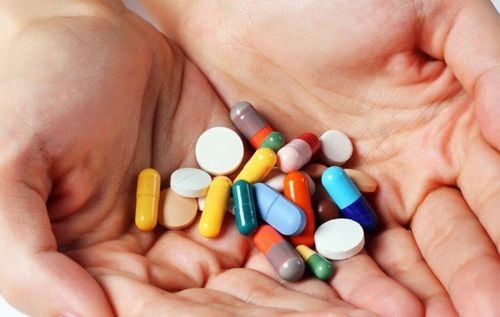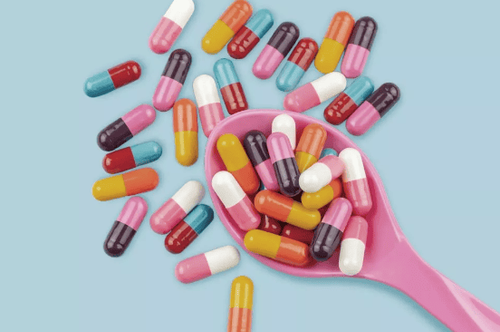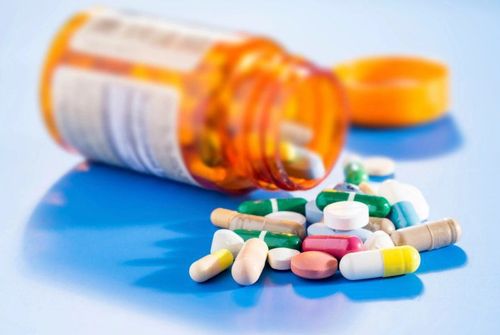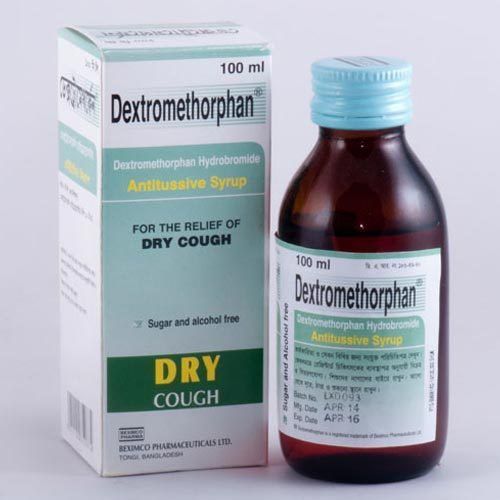This is an automatically translated article.
Antibiotics are used to treat or prevent certain types of bacterial infections by killing bacteria or preventing them from multiplying and spreading. Antibiotics are not effective against viral infections, such as the common cold, flu, and sore throat. Because many mild infections are cleared by the body's immune system without the use of antibiotics. However, if antibiotics are not prescribed and taken correctly, they can cause side effects and antibiotic resistance.1. Common side effects
All medications have side effects, and antibiotics are no exception. Antibiotics are drugs that treat infections by killing bacteria or other organisms or slowing their growth. An antibiotic side effect occurs as an unwanted reaction that occurs beyond the intended therapeutic effect of the antibiotic you are taking. These effects can range from a mild allergic reaction to a serious and debilitating side effect. When used appropriately, most antibiotics are relatively safe with few side effects. However, some side effects may interfere with your ability to finish your medication. In these cases, you should contact specialists for timely advice.A few common side effects include:
1.1. Stomach pain Many antibiotics cause stomach upset or other gastrointestinal side effects, including: Nausea, vomiting, cramps, diarrhea, bloating, loss of appetite, indigestion.
Most side effects go away on their own when you stop taking the medicine.
Serious gastrointestinal side effects can be caused by an overgrowth of harmful bacteria in your intestinal tract such as:
Blood or mucus in the stool Severe diarrhea Severe abdominal cramps or pain Fever Uncontrolled vomiting Macrolides, cephalosporins, penicillins, and fluoroquinolones can cause more stomach upset than other antibiotics.

Nhiều loại thuốc kháng sinh gây khó chịu cho dạ dày hoặc các tác dụng phụ khác về đường tiêu hóa
Symptoms of a yeast infection include:
Vaginal itching, swelling and pain Pain and burning sensation during intercourse and when urinating Abnormal vaginal discharge, usually grayish-white and lumpy Fever and chills A thick white coating in the mouth and throat Pain when eating or swallowing White patches on the throat, cheeks, palate or tongue Loss of taste 1.3. Sensitivity to the sun If you are taking antibiotics, such as tetracycline, your body may become more sensitive to light and may make your skin more susceptible to sunburn. The photosensitivity should go away after you finish taking the antibiotic.
While taking antibiotics you should:
Avoid prolonged exposure to light Always use a broad spectrum, high SPF sunscreen when out in the sun Wear protective clothing when out in the sun. 1.4. Fever Fever is a common side effect of many medications, including antibiotics. Drug fever can occur with any antibiotic, but they are more common with the following classes of antibiotics:
Beta-lactam Cephalexin Minocycline Sulfonamide

Sốt là tác dụng phụ thường gặp ở nhiều loại thuốc, kể cả thuốc kháng sinh
Stain may also appear on some bones. However, bone is constantly regenerating itself, so antibiotic-induced bone stains are usually reversible.
1.6. Drug interactions Some common drugs interact with certain antibiotics
Blood thinners Birth control pills (can only happen with rifamycins) Antacids Antihistamines Multivitamins and some supplements supplements, especially those high in zinc, iron, and calcium Non-steroidal anti-inflammatory drugs (NSAIDs) Psoriasis medications Rheumatoid arthritis medications Diuretics Antifungal drugs Diabetics Muscle relaxants Steroids Medicines Parkinson's Cyclosporine Lithium Retinoids and vitamin A supplements Cholesterol medications, including statins Migraine medications Gout medications Tricyclic antidepressants
2. Serious side effects
2.1. Anaphylaxis In rare cases, antibiotics can cause an extremely serious allergic reaction called anaphylaxis. Signs include:Fast heartbeat Red, itchy rash or hives Feelings of restlessness and agitation Feelings of tingling and dizziness Severe nausea, vomiting Itching and rash over large parts of the body Swelling swelling under the skin Swelling of the mouth, throat, and face Severe wheezing, cough and difficulty breathing Fainting Low blood pressure Convulsions Anaphylaxis usually develops very quickly, sometimes at the time of injection or within 15 minutes to 1 hours after antibiotic injection. Anaphylaxis can be fatal if not treated promptly. Therefore, always take the first dose of antibiotics in a medical facility.
2.2. Blood reactions Some antibiotics can cause changes in your blood.
Example: Leukopenia is a decrease in the number of white blood cells. It can lead to increased infections.
Another change is thrombocytopenia. This can cause bleeding, bruising, and slow blood clotting.
Beta-lactam antibiotics and sulfamethoxazole cause these side effects more often.
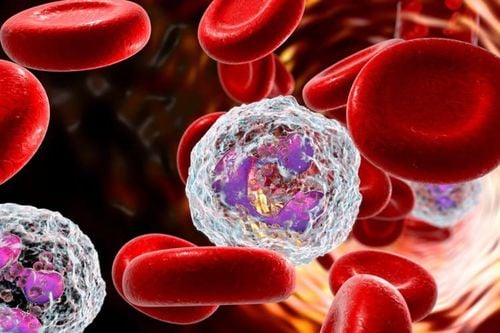
Một số loại kháng sinh có thể gây ra những thay đổi trong máu của bạn
Antibiotics commonly associated with these side effects are terbinafine, erythromycin, and some fluoroquinolones such as ciprofloxacin.
2.4. Tendonitis Tendonitis is inflammation or irritation of tendons (thick cords that attach bone to muscle and they can be found all over your body.
Antibiotics like ciprofloxacin have been reported to cause inflammation. tendon or tendon rupture
Everyone is at risk for tendon problems when taking certain antibiotics, however, some people are at higher risk of tendon rupture including:
Have existing kidney failure at Have had a kidney, heart or lung transplant Ever had tendon problems Taking steroids Elderly > 60 years old 2.5. Seizures Very rarely, convulsions are caused by antibiotics, convulsions are more common with ciprofloxacin, imipenem and cephalosporins such as cefixime and cephalexin
2.6 Stevens - Johnson syndrome Stevens-Johnson syndrome is a rare, but serious, disorder of the skin and mucous membranes that is a possible reaction. It happens more often with antibiotics like beta-lactams and sulfamethoxazole.
Usually, Stevens-Johnson syndrome begins with flu-like symptoms, such as a fever or sore throat. These symptoms may be followed by blisters and a widespread, painful rash. Other symptoms may include:
Fever Cough Swelling of face or tongue Pain of oral cavity and throat area 2.7. Bacteria resistant to antibiotics Some bacteria have developed resistance to antibiotics. Some infections are caused by a strain of antibiotic-resistant bacteria that do not respond to any of the antibiotics currently available.
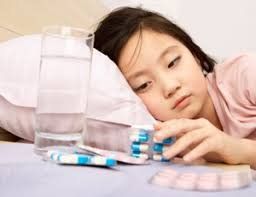
Một số vi khuẩn đã phát triển đề kháng với thuốc kháng sinh
Some ways to reduce the risk of developing antibiotic-resistant infections include:
Follow your doctor's instructions for taking antibiotics Always finish all prescribed doses of antibiotics right away even when symptoms are gone Never take antibiotics prescribed to someone else Never take antibiotics that are out of date or old Use antibiotics only when needed for bacterial infections Do not use antibiotics for symptoms of the common cold, such as a runny nose, cough, or wheezing Avoid using antibiotics regularly or for long periods of time unless necessary Return unused antibiotics to the pharmacy or throw them in the regular trash Never flush unused or leftover antibiotics down the toilet or drain Never break or crush antibiotic pills or tablets Avoid fruit and juices, milk and alcohol for 3 hours after taking a dose of antibiotic 2.8. Kidney failure The kidneys are responsible for removing toxins, including drugs, from the blood and body through urine. Antibiotics can overload your kidneys and damage them in people with kidney disease.
As people age, their kidneys also naturally become less efficient. Doctors will usually prescribe lower doses of antibiotics for older people or people with kidney disease.
2.9. Clostridium difficile colitis Clostridium difficile, or C. difficile, is a bacteria that can infect the large intestine and cause Clostridium difficile colitis, an infection that causes inflammation of the intestines and severe diarrhea.
C-difficile colitis is challenging to treat because the bacteria are resistant to most currently available antibiotics.
Severe, chronic, or untreated cases of C-difficile colitis can lead to death.
3. List of some typical antibiotics and their side effects
| Các loại kháng sinh phổ biến | Các thành viên nhóm kháng sinh | Các tác dụng phụ thường gặp nhất | Nhận xét lâm sàng bổ sung |
| Danh sách các penicillin , các penicillin kháng penicillin và các thuốc loại penicillin khác |
- Penicillin - Amoxicillin (Amoxil) - Amoxicillin và clavulanate (Augmentin) - Thuốc ampicillin piperacillin và tazobactam (Zosyn) nafcillin (Nallpen) oxacillin |
- Phát ban da - Bệnh tiêu chảy - Đau bụng - Buồn nôn và ói mửa - Sốt - Phản ứng quá mẫn (dị ứng)" |
Nếu phân có máu, tiêu chảy nhiều nước, phân có mủ, sốc phản vệ (dị ứng nặng), đau dạ dày khẩn cấp, phản ứng da nghiêm trọng hoặc sốt, hãy đến ngay cơ sở y tế gần nhất. Thuốc kháng sinh có thể gây viêm đại tràng giả mạc và nhiễm trùng Clostridium difficile đe dọa tính mạng . |
| Danh sách cephalosporin |
- cephalexin (Keflex) - cefaclor - cefadroxil (Duricef) - cefazolin (Ancef) - cefepime (Maxipime) - cefotaxime (Claforan) - ceftaroline (Teflaro) - cefuroxime (Ceftin, Zinacef) - cefdinir - cefixime - ceftriaxone |
- phát ban - bệnh tiêu chảy - buồn nôn và nôn (hiếm gặp) - phản ứng quá mẫn (dị ứng) - bệnh huyết thanh - nấm Candida âm đạo - Aztreonam (Azactam) không có phản ứng chéo với các kháng sinh beta-lactam khác và có thể được sử dụng an toàn ở những bệnh nhân bị dị ứng beta-lactam được báo cáo (ngoại trừ những bệnh nhân dị ứng với ceftazidime). Mặc dù phản ứng chéo của aztreonam với các kháng sinh beta-lactam khác là rất hiếm, nhưng dùng thận trọng cho bất kỳ bệnh nhân nào có tiền sử quá mẫn với beta-lactam (ví dụ, penicilin, cephalosporin và / hoặc carbapenems). |
Quá mẫn chéo có thể xảy ra ở những bệnh nhân bị dị ứng với penicillin được ghi nhận; có thể phổ biến hơn với cephalosporin thế hệ đầu tiên do sự tương đồng về cấu trúc. Trong một nghiên cứu tiền cứu, tỷ lệ phản ứng chéo giữa các đối tượng có xét nghiệm da dương tính với penicillin là 6%; tuy nhiên tỷ lệ lên đến 10% đã được báo cáo. Nếu bạn có tiền sử dị ứng với penicilin, bác sĩ có thể đề nghị xét nghiệm da với penicilin nếu cần dùng cephalosporin. |
| Danh sách các aminoglycoside |
- amikacin - gentamicin - neomycin - tobramycin |
- độc tính thận - độc tính trên tai ( mất thính giác ) - chóng mặt - buồn nôn và ói mửa - rung giật nhãn cầu (cử động mắt không tự chủ) Các aminoglycosid kéo dài hoặc điều trị nhiều đợt có thể dẫn đến nguy cơ cao hơn gây độc cho tai (tổn thương thính giác) và độc thận (thận). |
Aminoglycoside thường được dự trữ cho những thời điểm không thể sử dụng các kháng sinh ít độc hơn hoặc không hiệu quả. Aminoglycoside không được hấp thu tốt qua đường uống và thường được dùng bằng đường tiêm. Neomycin được đưa qua đường uống vì tác dụng của nó trong ruột, mặc dù nó có thể được hấp thu và các phản ứng độc hại có thể xảy ra |
| Danh sách các carbapenems |
- meropenem (Merrem) - ertapenem (Invanz) - imipenem và cilastatin (Primaxin) |
- bệnh tiêu chảy - buồn nôn và ói mửa - đau đầu - phát ban - nhiễm độc gan - tăng bạch cầu ái toan (mức độ cao của một loại tế bào bạch cầu) |
Các phản ứng quá mẫn được báo cáo với meropenem và imipenem ở những bệnh nhân bị dị ứng với penicillin. |
| Danh sách các chất chống bệnh lao |
- dapsone - ethambutol (Myambutol) - isoniazid - pyrazinamide - rifabutin (Mycobutin) - rifampin (Rifadin, Rimactane) |
- Bệnh tiêu chảy - buồn nôn và ói mửa - chán ăn - chứng tan máu, thiếu máu - nhiễm độc gan - đau đầu |
Các hiệu ứng bên khác nhau giữa các tác nhân, kiểm tra từng tác nhân. Vitamin B6 (pyridoxine) có thể được dùng để giúp ngăn ngừa bệnh thần kinh ngoại vi với isoniazid |
| Danh sách glycopeptide |
- telavancin (Vibativ) - vancomycin (Vancocin) |
vancomycin : "hội chứng người đỏ" (RMS) - đỏ bừng, hạ huyết áp, ngứa khi sử dụng IV; viêm tĩnh mạch telavancin : thay đổi vị giác, buồn nôn / nôn, nhức đầu, chóng mặt |
Truyền vancomycin qua đường tĩnh mạch trong hơn 60 phút có thể giúp ngăn ngừa RMS. Các trường hợp khác của RMS do kháng sinh khác đã được báo cáo, bao gồm: rifampin, cefepime, Teicoplanin, ciprofloxacin, và amphotericin B. |
| Danh sách thuốc kháng sinh macrolid |
- azithromycin (Azithromycin, Z Pak) - clarithromycin (Biaxin) - erythromycin (EES, EryPed, Ery-Tab, Erythrocin) |
- đau bụng - bệnh tiêu chảy - chán ăn - buồn nôn và ói mửa - thay đổi mùi vị (clarithromycin) |
Tỷ lệ cao các tác dụng phụ trên đường tiêu hóa (dạ dày). Không nghiền, nhai, bẻ, mở thuốc bao tan trong ruột hoặc thuốc giải phóng chậm. |
| Danh sách các sulfamid (kháng sinh) |
- sulfacetamide natri tại chỗ (Klaron, Ovace) - sulfadiazine (chung) - sulfamethoxazole và trimethoprim (Bactrim, Co-trimoxazole, Septa, SMZ-TMP) |
- buồn nôn và ói mửa - bệnh tiêu chảy - chán ăn (chán ăn) - bụng (đau dạ dày) - phát ban - đau đầu - chóng mặt - cảm quang - Tránh tiếp xúc lâu với ánh nắng mặt trời; sử dụng kem chống nắng và mặc quần áo bảo vệ. |
Phản ứng dị ứng với sulfonamide đã được báo cáo ở khoảng 1,5% đến 3% dân số nói chung. Tìm hiểu thêm về dị ứng sulfa tại đây. Có thể dẫn đến các phản ứng nghiêm trọng trên da: Hội chứng Stevens Johnson, hoại tử biểu bì nhiễm độc. |
| Danh sách các tetracycline |
- tetracycline (Achromycin V) - doxycycline (Acticlate, Morgidox, Vibramycin) - minocycline - omadacycline (Kozyra) |
- buồn nôn và ói mửa - bệnh tiêu chảy - chán ăn - đau bụng - đổi màu răng ở trẻ em <8 tuổi - nhiễm độc gan - cảm quang - Tránh tiếp xúc lâu với ánh nắng mặt trời, sử dụng kem chống nắng, mặc quần áo bảo vệ. |
Sự phát triển của sự đề kháng của vi khuẩn đã hạn chế hiệu quả của nhóm thuốc này, mặc dù chúng vẫn có thể được sử dụng trong y học cho người và động vật. |
| Danh sách các fluoroquinolone (quinolon) |
- ciprofloxacin ( Cipro ) - ciprofloxacin phóng thích kéo dài ( Cipro XR ) - gemifloxacin (Factive) - levofloxacin (Levaquin) - moxifloxacin (Avelox) - ofloxacin (chung) |
- buồn nôn và ói mửa - bệnh tiêu chảy - đau bụng - đau đầu - hôn mê - mất ngủ (khó ngủ) - nhạy cảm với ánh sáng (có thể nghiêm trọng) |
Do nguy cơ xảy ra các phản ứng có hại nghiêm trọng, các bác sĩ có thể ngừng sử dụng loại thuốc này trừ khi thực sự cần thiết cho các trường hợp nhiễm trùng nghiêm trọng hơn hoặc không phản ứng. Tránh tiếp xúc lâu với ánh nắng mặt trời; sử dụng kem chống nắng, mặc quần áo bảo vệ. Xem cảnh báo của FDA và cảnh báo đóng hộp đối với fluoroquinolon : đứt gân, viêm gân, bệnh thần kinh ngoại vi, làm trầm trọng thêm bệnh nhược cơ, phình hoặc bóc tách động mạch chủ, lượng đường trong máu thấp, thay đổi trạng thái tâm thần. |
| Danh sách các dẫn xuất lincomycin |
- clindamycin (Cleocin) - lincomycin (Lincocin) |
- viêm đại tràng giả mạc (có thể nặng và đe dọa tính mạng) - bệnh tiêu chảy - buồn nôn và ói mửa - phát ban - dị ứng - vàng da (clindamycin) |
Nếu tiêu chảy nghiêm trọng trong khi điều trị hoặc trong 8 tuần sau khi điều trị, hãy tham khảo ý kiến nhà cung cấp dịch vụ chăm sóc sức khỏe ngay lập tức, có thể là viêm đại tràng màng giả ( C. difficile ); xem xét sử dụng các tác nhân ít độc hại hơn. |
| Thuốc kháng sinh khác | metronidazole (Flagyl) |
- vị kim loại - buồn nôn và ói mửa - chóng mặt - đau đầu - nhiễm trùng nấm âm đạo |
Tránh sử dụng rượu và hoặc sử dụng propylene glycol trong khi điều trị và trong tối đa 3 ngày sau khi ngừng điều trị. Sử dụng kết hợp với rượu có thể dẫn đến chuột rút, buồn nôn / nôn, đỏ bừng, nhức đầu; có thể đổi màu nước tiểu thành màu nâu đỏ. |
Please dial HOTLINE for more information or register for an appointment HERE. Download MyVinmec app to make appointments faster and to manage your bookings easily.
References: medicalnewstoday.com, healthline.com, drugs.com




